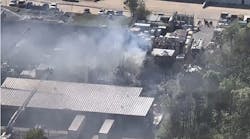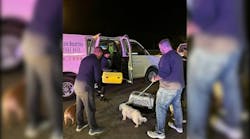I recently saw something that made my blood boil and my skin crawl. Unfortunately, it is not the first time I saw it or heard of it. What I saw did not happen in a remote town or on a desolated highway where nobody else could see it. This happened in a heavily traveled area of a large city.
Here is what I saw: While staying at a downtown hotel in a major city, I happened to be walking out the front door lobby and onto the street. As I exited the door, I could hear a siren approaching from my left. It was an engine company. What I did not see was the commotion occurring to my right. There, sitting on the sidewalk was an older woman who was apparently having some type of medical emergency. The doorman and several others were gathered around her and trying to comfort her until assistance arrived. While this was going on, other people continued to walk by, while others stood back and watched.
As I watched the engine company coming down the street, the apparatus slowed and eventually stopped in front of the emergency that was happening to my right. After the engine company stopped, the firefighter who was seated in the rear cab behind the company officer jumped out and headed toward the woman. As he walked toward the scene, he put on his protective gloves, but he was not carrying any equipment. He squatted next to the woman and started getting a short history from her and the bystanders. It was apparent that she was having trouble breathing.
Shortly after this happened, the firefighter who was seated behind the driver/engineer got out and walked around to the other side of the engine. He stayed by the engine and did not approach the scene. The company officer also got out and stood by the firefighter standing next to the engine. These two made small talk and never made any effort to approach the scene to see whether their assistance was needed or whether the firefighter attending to the woman needed any equipment.
The firefighter who was tending to the patient got up and walked over to a rear compartment on the engine and took out a bottle of oxygen. He returned to the patient and placed her on oxygen by using a nasal cannula. Then, in an unbelievable act, the firefighter standing by the engine took out a pack of cigarettes, put one in his mouth and lit it. He continued to smoke the cigarette while chatting with the company officer. In the distance, I could hear a siren that I could only assume was from an ambulance. The siren got closer and I saw it was an ambulance responding to the scene. The ambulance arrived at the scene and was parked behind the engine. Two medics got out and walked over the scene where the woman was sitting on the sidewalk. The firefighter and company officer who were standing next to the engine did not acknowledge the medics, but turned and got into their respective seats in the cab of the engine. The firefighter who was tending to the patient gave a short report, retrieved his oxygen and left the patient in the care of the two medics. The firefighter put the oxygen away in the rear compartment, hopped into the rear cab and then, in a cloud of diesel exhaust that shot onto the patient and the crowd on the sidewalk, the engine pulled away.
Have you ever been part of a scene of this type? Maybe you were the company officer. Maybe you were the firefighter smoking the cigarette. Possibly, you were a bystander witnessing this scene, like I was. Maybe you have seen worse. I have and actually had to investigate the incident.
In that particular scenario, an engine company responded to the scene of an automobile accident where a patient was complaining of neck and back pain. All four members of the engine company properly extricated the patient with a cervical collar and backboard, strapped her to the backboard, laid her on the sidewalk, and were taking her vital signs while they awaited the arrival of the ambulance.
While they were awaiting the arrival of the ambulance, a house fire was dispatched in their immediate response district. All four members of the engine company jumped on the engine, leaving the patient lying alone on the sidewalk with a non-medically trained police officer, and responded to the house fire. Besides patient abandonment, what would have happened if the patient began to vomit while she was immobilized to the backboard? What would happen if she started having some other type of medical complication?
Both of these cases demonstrate unprofessional actions on the part of first responders. Happily, I can report, based upon my experiences, that these incidents are the exception more than the rule. It has been my experience that the vast majority of firefighters in the United States who respond on medical runs perform in an exemplary manner. Unfortunately, a few bad apples can spoil it for the rest.
To some, medical responses are not as exciting as a house fire. Others have gone on too many first-responder runs that were not true emergencies. Many still are resistant because they joined the fire service to be firefighters and were forced to go on medical runs when their departments made the move operationally. Still others mainly see medical runs as a necessary evil to bolster run numbers for their department and justify their jobs.
Citizens expect four things when they dial 911: an immediate and fast response; professionalism from those who respond; a level of care that is the best possible; and that those who respond show compassion.
It is important to remember that medical first response is a major component of what the fire service provides, even though many fire departments have more engine or ladder companies than ambulances. The whole concept of a first-responder program is to get medical intervention quickly to someone who is having a medical emergency. Since there are usually more engine or ladder companies than ambulances, the logical conclusion is to use companies that are statically and geographically deployed, and number more than ambulances.
What is important is the perception that first responders give to those on a scene. Unlike fire calls, almost every medical emergency deals with people in some fashion. Interaction and actions taken by the first responders on the scene sends volumes of signals to the public.
First response is one main staple of fire departments today. Quick response, professionalism, providing the right level of care for the type of emergency the patient is experiencing and compassion are all key ingredients to a successful first-responder program.
Gary Ludwig, MS, EMT-P, a Firehouse® contributing editor, is the chief of Special Operations for Jefferson County, MO. He retired in 2001 as the chief paramedic for the St. Louis Fire Department after serving the City of St. Louis for 25 years. He is also vice chairman of the EMS Section of the International Association of Fire Chiefs (IAFC). He is a frequent speaker at EMS and fire conferences nationally and internationally, and is on the faculty of three colleges. Ludwig has a master’s degree in management and business and a bachelor’s degree in business administration, and is a licensed paramedic. He also operates The Ludwig Group, a professional consulting firm. He can be reached at 636-789-5660 or via www.garyludwig.com.




